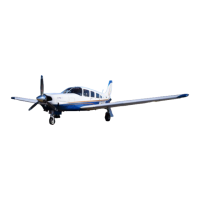
Do you have a question about the Piper Aircraft Corporation PA-32R-301T and is the answer not in the manual?
| Brand | Piper Aircraft Corporation |
|---|---|
| Model | PA-32R-301T |
| Category | Aircrafts |
| Language | English |
Maximum takeoff, landing, and ramp weights.
Forward and rearward center of gravity limits by weight.
Never exceed, structural cruising, and maneuvering speeds.
Maximum takeoff, ramp, and baggage weights.
Checklist for engine fire during start and power loss during takeoff.
Procedures for engine power loss during flight.
Actions for electrical or engine fires in flight.
Procedure for high oil temperature indication.
Procedure for propeller overspeed.
Procedure for inadvertent spin recovery.
Procedure for engine fire during start.
Procedure for complete engine power loss in flight.
Detailed procedure for power-off landings.
Procedure for fire in flight, including electrical and engine fires.
Procedure for partial or complete loss of oil pressure.
Procedure for engine driven fuel pump failure.
Procedure for electrical overload conditions.
Procedure for propeller overspeed.
Procedure for inadvertent spin recovery.
Procedures for executing a power-off landing.
Procedure for loss of oil pressure.
Procedure for alternator failure or loss of electrical power.
Procedure for emergency landing gear extension.
Actions for engine power loss during takeoff.
Procedure for loss of fuel flow, including pump failure.
Procedure for high oil temperature indication.
Procedure for emergency landing gear extension.
Procedure for loss of fuel flow, including pump failure.
Procedure for electrical overload conditions.
Procedure for loss of alternator output.
Procedure for engine driven fuel pump failure.
Preflight check for the cockpit.
Pre-engine start checks and procedures.
Procedure for starting a flooded engine.
Ground check procedures including parking brake, magnetos, and gauges.
Normal takeoff technique.
Cockpit checks upon entry.
Procedures before starting the engine.
Ground check procedures including magnetos and propeller.
Pre-takeoff checks and considerations.
Normal takeoff technique.
Normal technique for approach and landing.
Procedure for starting the engine when cold.
Final checks before takeoff.
Normal technique for approach and landing.
Procedures for starting the engine when cold, hot, or flooded.
Stall characteristics and speeds.
Procedure for starting the engine when hot.
